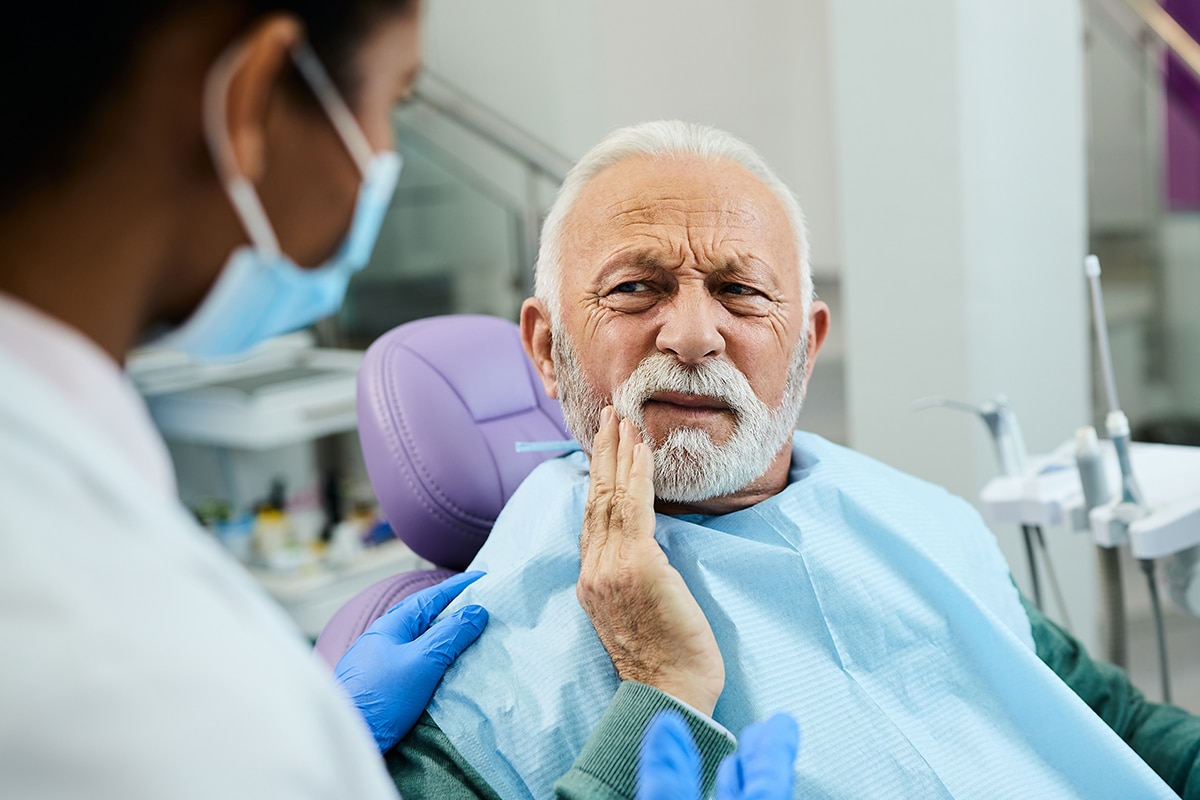As the average lifespan increases, so does the prevalence of age-related oral health problems. Yet treatment for dental problems in older adults is easier when caught early.
These are four common dental problems older adults should be aware of and guard against.
Tooth Decay
Tooth decay is a problem in older adults. The prevalence of tooth decay increases with age, affecting 92% of adults ages 20-64 years and virtually 100% of older adults.
Many older adults have had lifetime exposure to sugar and other foods that contribute to tooth decay. And as people get older, saliva flow decreases, making the mouth more susceptible to infections like tooth decay.
Seniors may have health problems affecting their oral health, such as dry mouth and diabetes. Dry mouth occurs when the salivary glands don't make enough saliva to keep the mouth wet (this condition is also called xerostomia). Without enough saliva, the mouth is vulnerable to infection and tooth decay. Saliva helps prevent tooth decay by washing away food particles, neutralizing acids produced by bacteria in plaque on teeth, and helping repair (remineralize) early stages of tooth decay.
Gum and Periodontal Disease
Gum and periodontal disease is an inflammatory condition of the gums and bone surrounding the teeth. It results in swelling and bleeding and can cause tooth loss. Gum disease is a pervasive problem in older adults, affecting as many as three out of four people over the age of 65. Because gum disease may not cause any pain and there are often no symptoms, it's essential to have regular dental checkups so that it can be caught early and treated effectively.
Gingivitis is a mild form of periodontal disease that can usually be reversed with daily brushing, flossing, and regular cleaning by a dentist or dental hygienist. Gingivitis is inflammation of the gums, usually caused by a bacterial infection. If you have gingivitis, your gums may be red, swollen, and bleed easily.
If gingivitis isn't treated, it can advance to periodontitis—a more severe form of gum disease that can eventually lead to tooth loss. Periodontitis occurs when toxins produced by bacteria irritate and damage the gum tissue and bone supporting your teeth. Pockets form between your teeth and gums as these structures are destroyed, creating spaces that collect plaque and debris. This debris can become infected, causing further destruction of the tissue and bone.
Dental Erosion
Dental erosion is a problem in older adults that can lead to tooth loss, discomfort, and difficulty chewing. It's important to know the causes of dental erosion so you can stop it before it starts.
Dental erosion occurs when the enamel—the outer layer of the tooth—wears away. Dental enamel doesn't heal. Once it's gone, there’s no way for it to grow back. Over time, this can lead to painful sensitivity and eventual tooth loss.
The most common cause of dental erosion is diet. Citric acids found in fruits and fruit juices can cause dental erosion. Carbonated beverages and energy drinks contain high acidity levels and are common culprits for causing dental erosion. Even coffee, wine, and tea have low acidity levels that can cause damage over time.
The best way to prevent dental erosion is by being aware of foods that can cause it, avoiding them or eating them in moderation, and taking care of your teeth through regular brushing and flossing.
Oral Cancer
Oral cancer is a serious concern for older adults, especially those who smoke or use smokeless tobacco. However, oral cancer patients have significantly better survival rates with early detection and treatment.
Older adults are at greater risk of oral cancer than younger people:
- More than two-thirds of all oral cancers occur in people 55 and older.
- More than 90 percent of cases occur in people 40 and older.
Risk factors for oral cancer include using tobacco products, alcohol consumption, exposure to the sun (especially when combined with fair skin), and HPV infection. The prevalence of oral cancer increases with age.
Look for these signs:
- A sore in the mouth that doesn’t heal
- Red or white patch on the gums, tongue, or lining of the mouth
- A lump or thickening in any part of the mouth, including under the tongue
- Difficulty swallowing or chewing, pain when swallowing or chewing
- Persistent earache
Early detection is vital because oral cancer often has no symptoms during its early stages. The five-year survival rate doubles if the disease is caught before it spreads to the lymph nodes of the neck.
For Lifelong Dental Health, Visit Your Dentist Regularly
To maintain lifelong dental health, good oral hygiene and regular visits to your dentist for checkups and cleanings are essential. If you notice a problem with your teeth, gums, or other tissues of the mouth, schedule an appointment immediately.
To schedule an appointment, contact Koppelman Dental today at 212-382-3782 .

